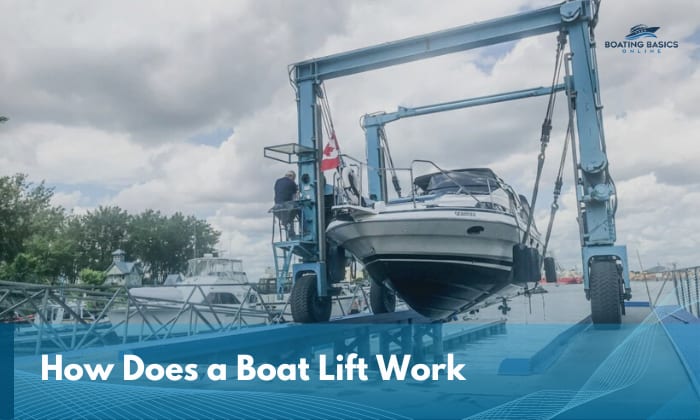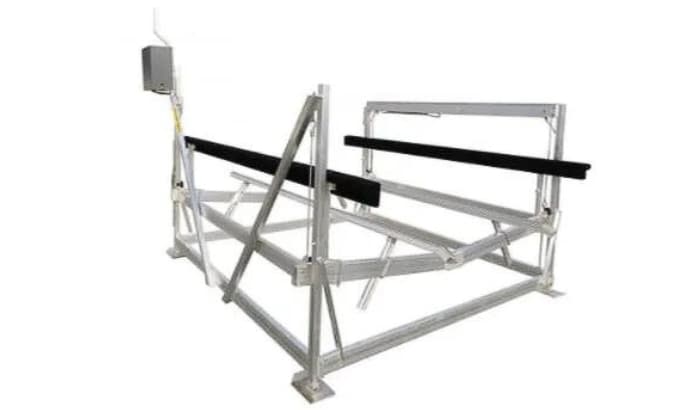Many boaters encounter the dilemma of keeping their vessel in the water or investing in a boat lift instead. Often, this sends the uninitiated scratching their heads and asking, “What’s that? How does a boat lift work exactly?”
The main purpose of a boat lift is to keep the boat from being in direct contact with the water while not in use. Once you raise the boat using the lift, its hull will be shielded from damage, and it will be better protected against storms and corrosion, to cite a few benefits.
For a more detailed explanation of the exact boat lift operation, continue reading.
Table of Contents
How Does a Boat Lift Operate?
It’s a given that any kind of boat lift fulfills the main purpose of keeping a watercraft out of the water should the need arise. However, there are subtle differences in how each one operates, which is usually dictated by the variety of boat lift types available.
- Bottom-standing lifts can be raised or lowered manually but can also be run by a hydraulic system or electric motor. They’re usually preferred for warm climates and shallow waters (up to nine feet).
- Floating lifts require electric power and rely on the buoyancy of air-filled chambers or tanks for their raising ability. When the boat is ready to be launched again, the chambers become flooded with water again, making the boat float.
- Piling mount lifts rely on a set of cables to suspend the boat. These cables are connected to a boat lift winch. This winch is responsible for pulling the boat out of the water and raising it to the desired height.
- Shore-mounted lifts run with the use of an extending ramp that can reach the water from the shoreline.
Once deployed, the boat operator needs only to drive it up to the ramp. Similar to piling mount lifts, this type also uses a winch to pull the boat up, but it’s often more expensive.
Now that I’ve mentioned it, if you’re on a boat as the operator, it’s equally important to learn how to correctly position boat on the lift as demonstrated in this video:
Use idle speed to approach the lift, turn the wheel in the direction you want to go, then move forward.
Of course, you also have to know how to operate a boat lift that you installed. In an Econo Lift floating lift, for example, the process can be summed up as follows:
- Position the boat close to the dock’s center.
- Turn the black handle to ‘RAISE’ and activate the blower to start the lifting.
- Turn off the blower and return the black handle to ‘HOLD’.
What about if you need to lower it?
- Just turn both the black and red handles to ‘LOWER’.
- Once it’s in the water, return both handles to ‘HOLD’.
This is just one boat lift product, of course. You’ll ultimately have to refer to the manufacturer’s instructions for the specific model you’ve installed to ensure that you’re operating it properly.
Boat Lift Usage Tips
If you’re not too confident yet when using your boat lift, just remember and recall these guidelines:
- Always remember that there are different capacities of boat lift weights. Certain lifts may only be limited to handling a little over 1,000 pounds while others, like the more sophisticated hydraulic options, can manage more than 10,000 pounds.
Make sure your boat’s total weight will not exceed that to reduce the risk of untoward accidents.
- Consider adding correct cable weights to your setup if your cables tend to not keep straight due to the flow of the current. This makes your setup more stable overall.
- During stormy weather, it’s safe practice to raise your boat as high as possible.
- Regularly check for visible signs of damage for added peace of mind.
Conclusion
I hope I’ve given you a satisfactory rundown and answer to your question, “How does a boat lift work?” It’s surely a nifty contraption, considering the alternative.
The fact that there are numerous types you can choose from goes to show that the technology is still being actively improved over time.
These lifts may be designed for optimal safety, but be sure to take the time to get the hang of them and maintain them over time.

“My intention from the first day establishing Boating Basics Online is to provide as much help as possible for boaters who want to experience a first safe and convenient trip. So feel free to join us and share your beautiful journeys to the sea!”



